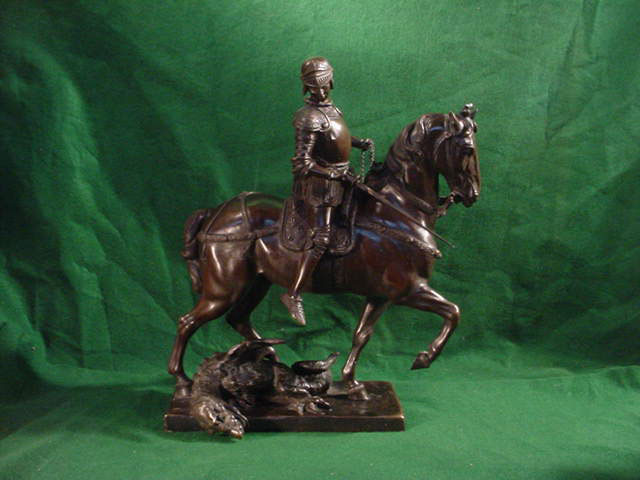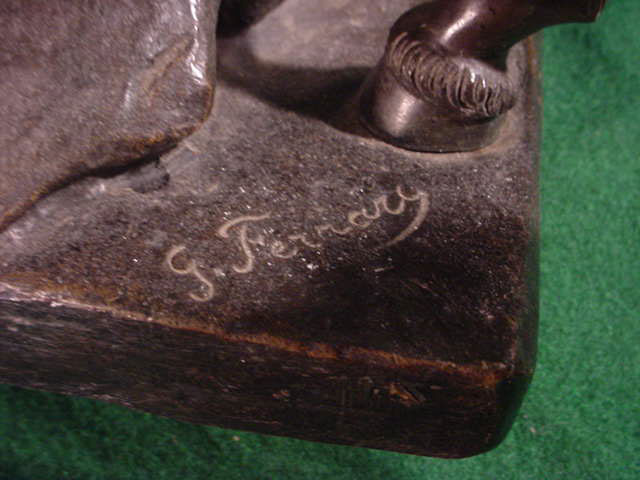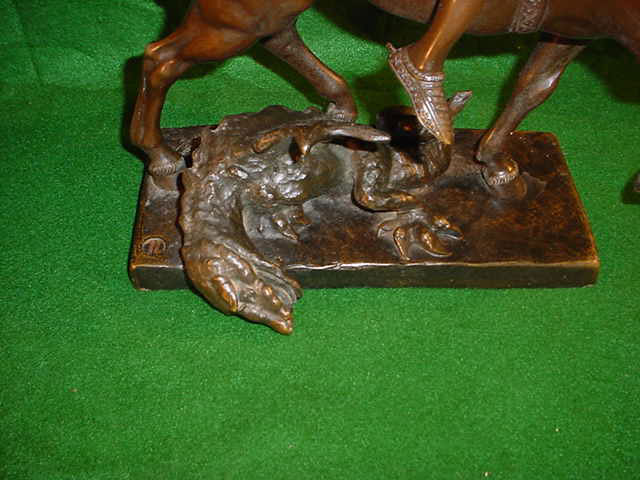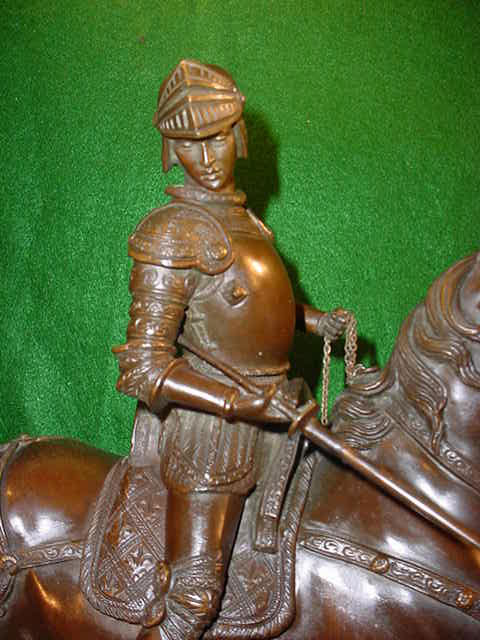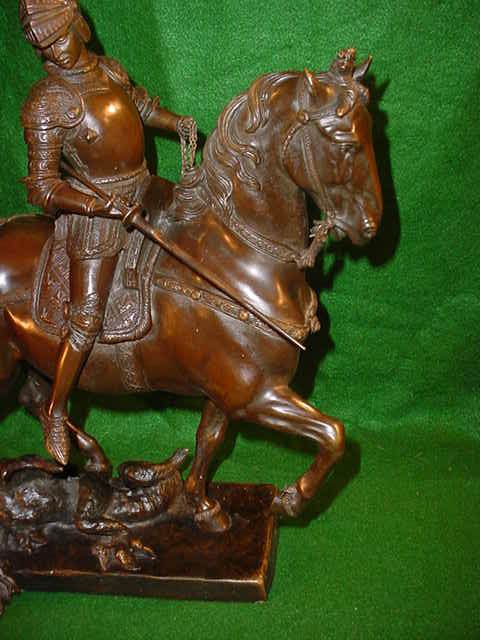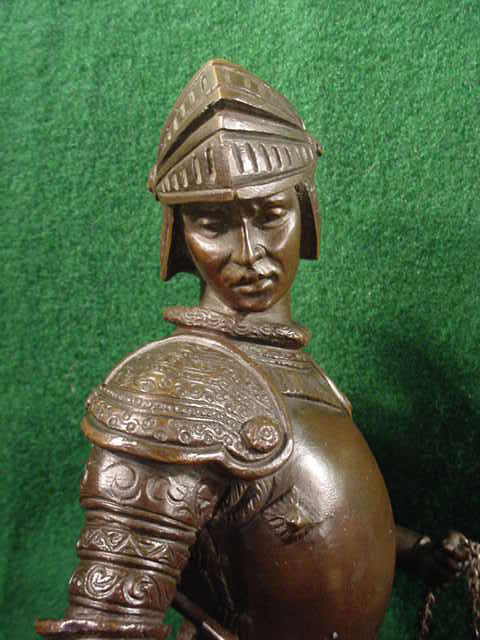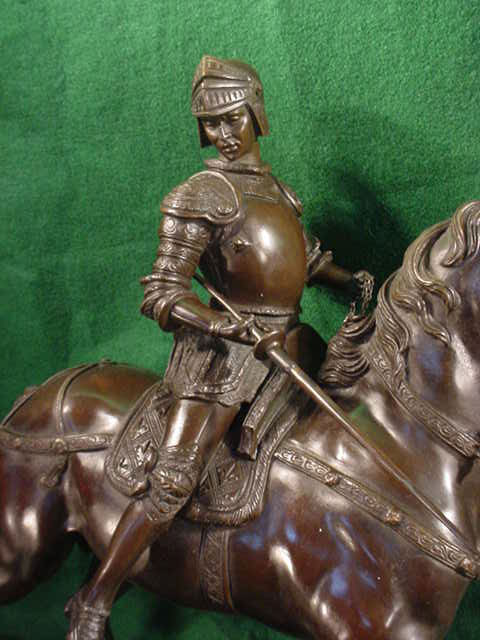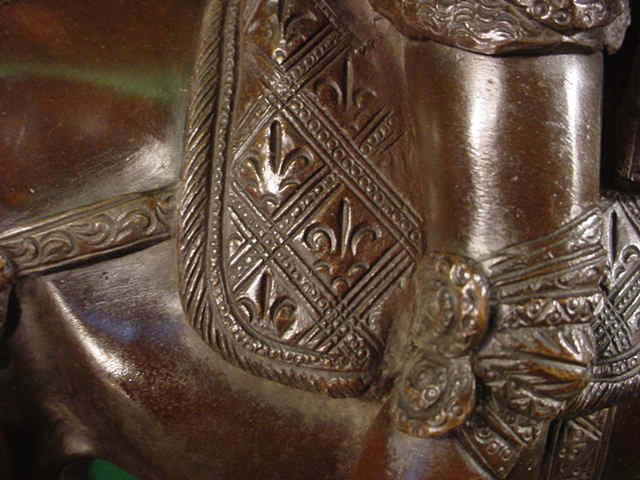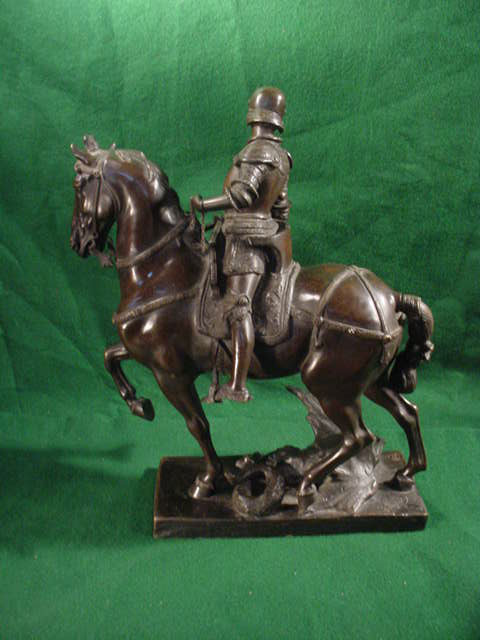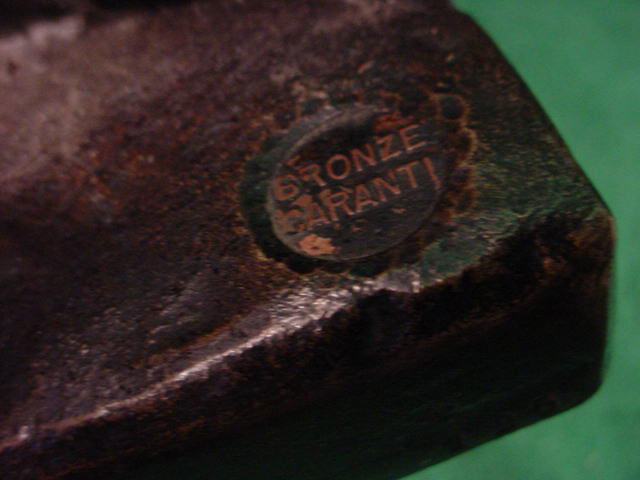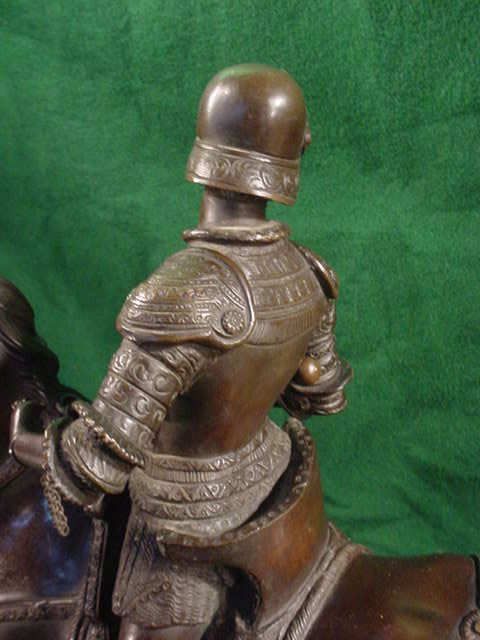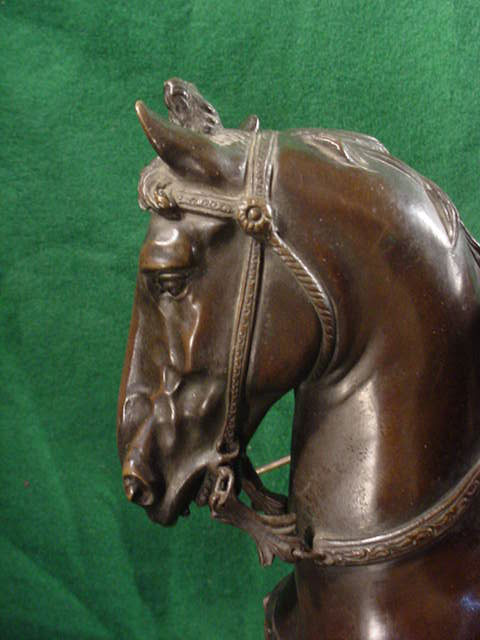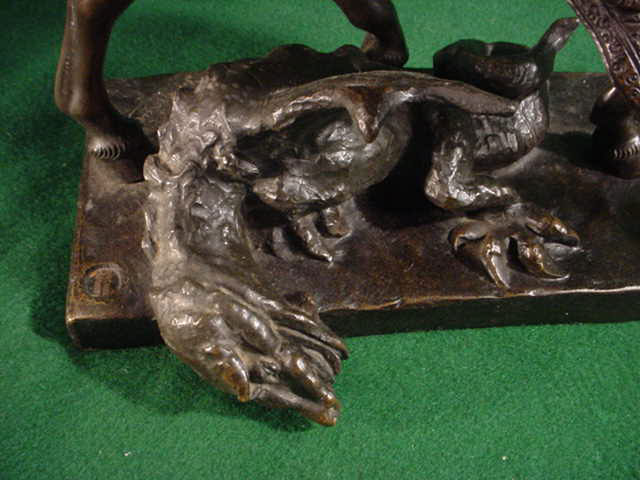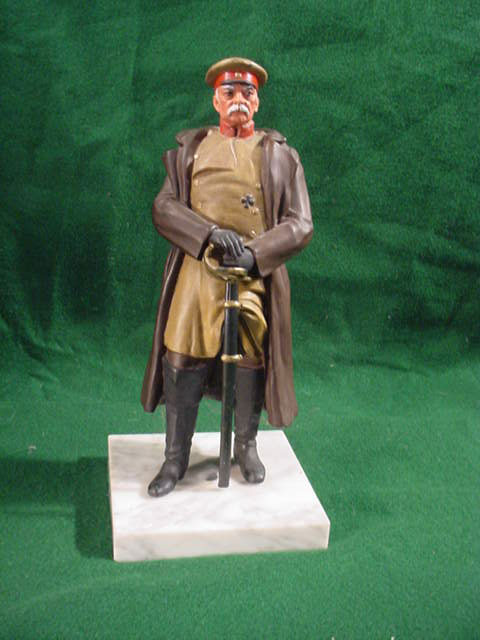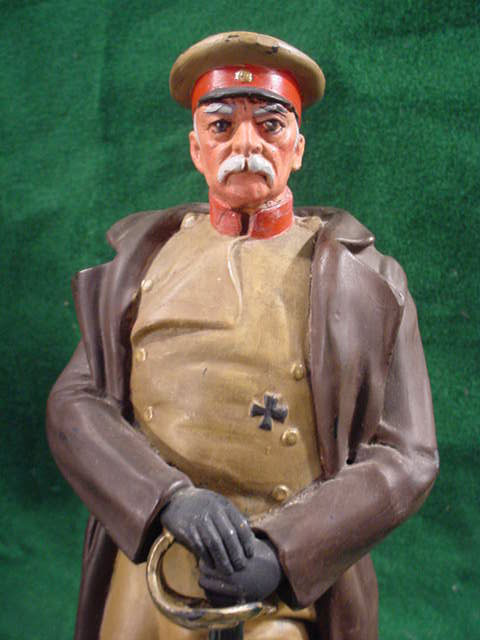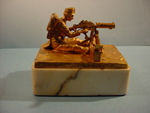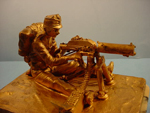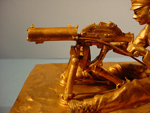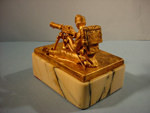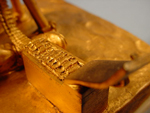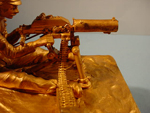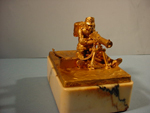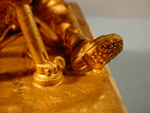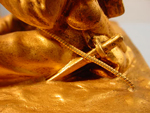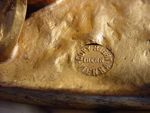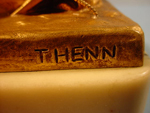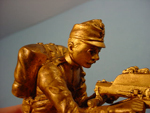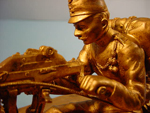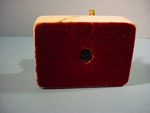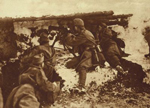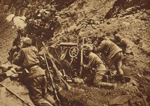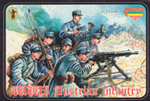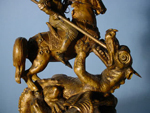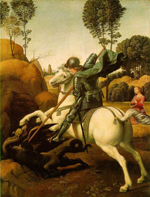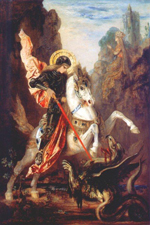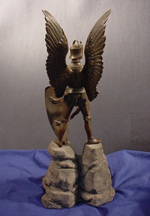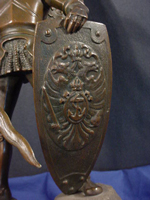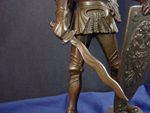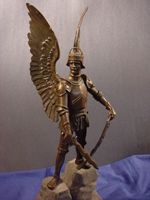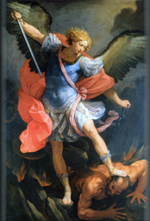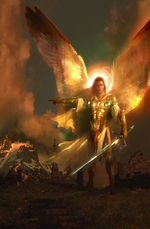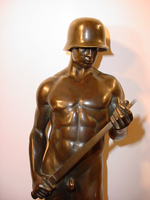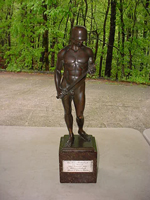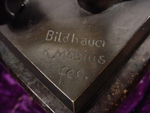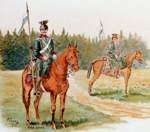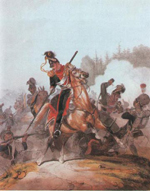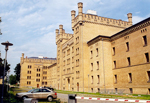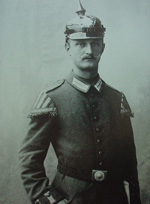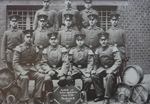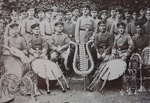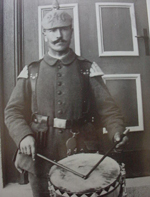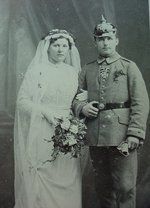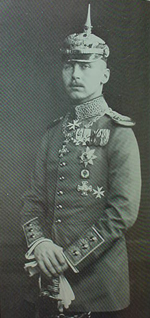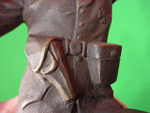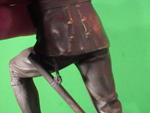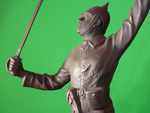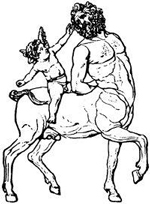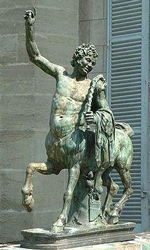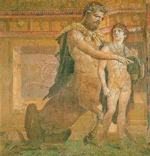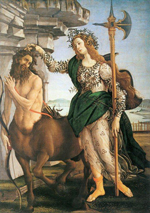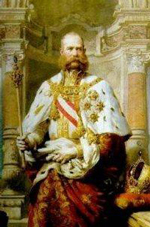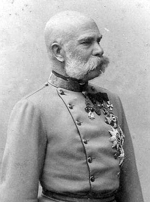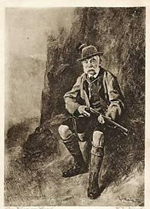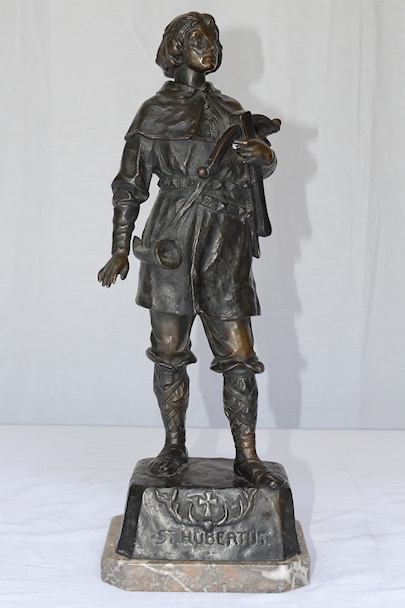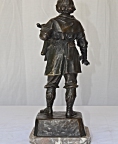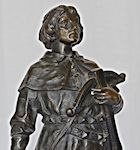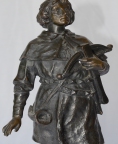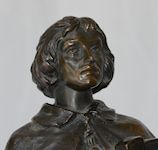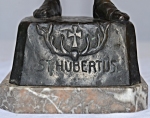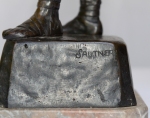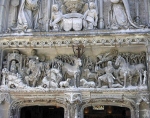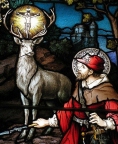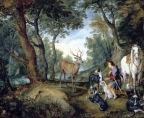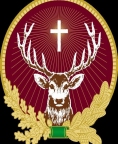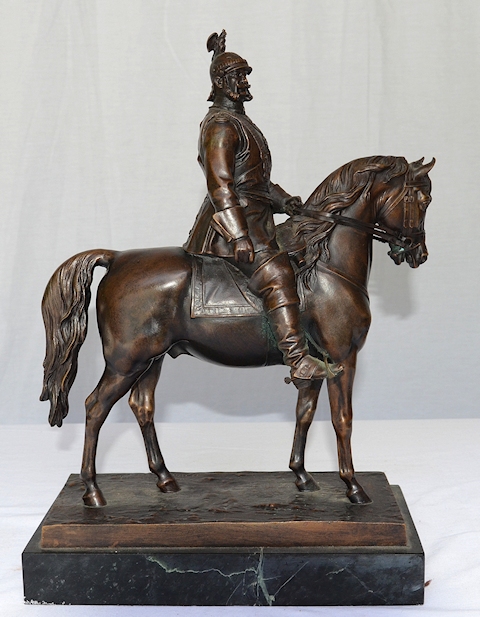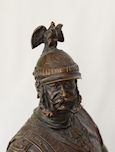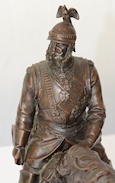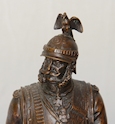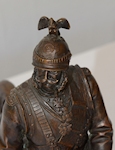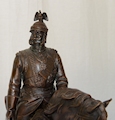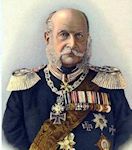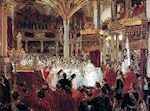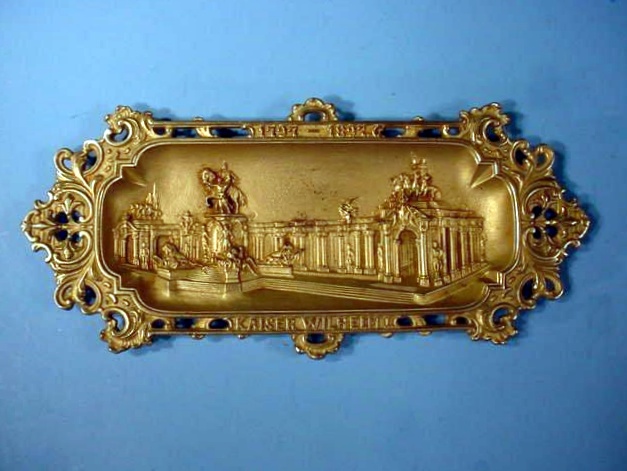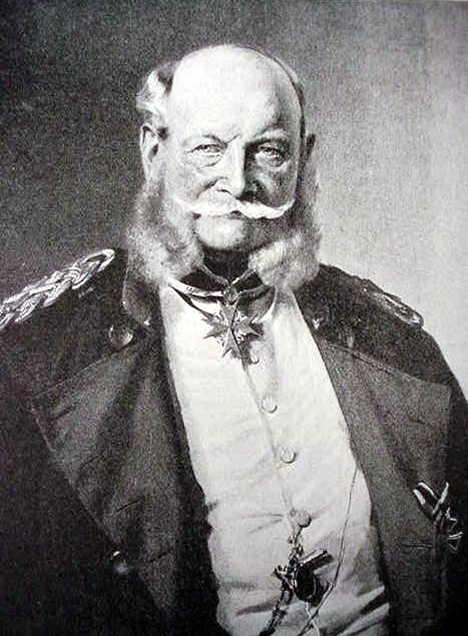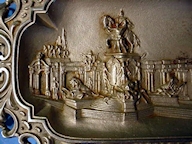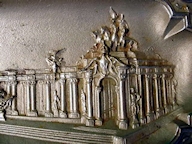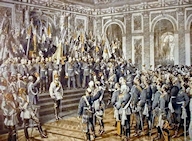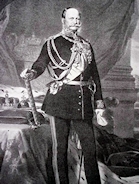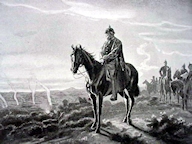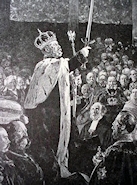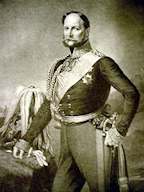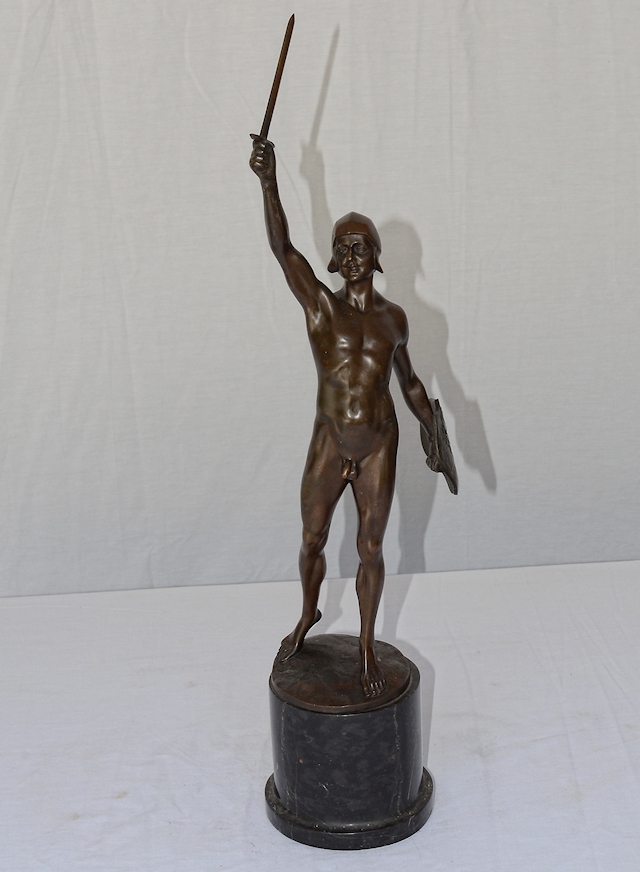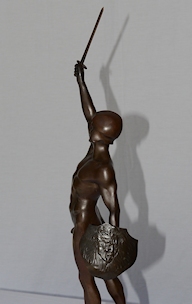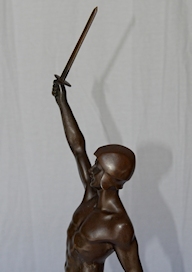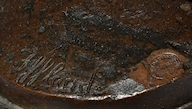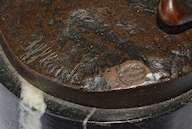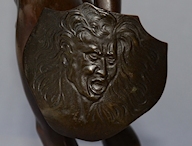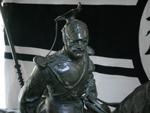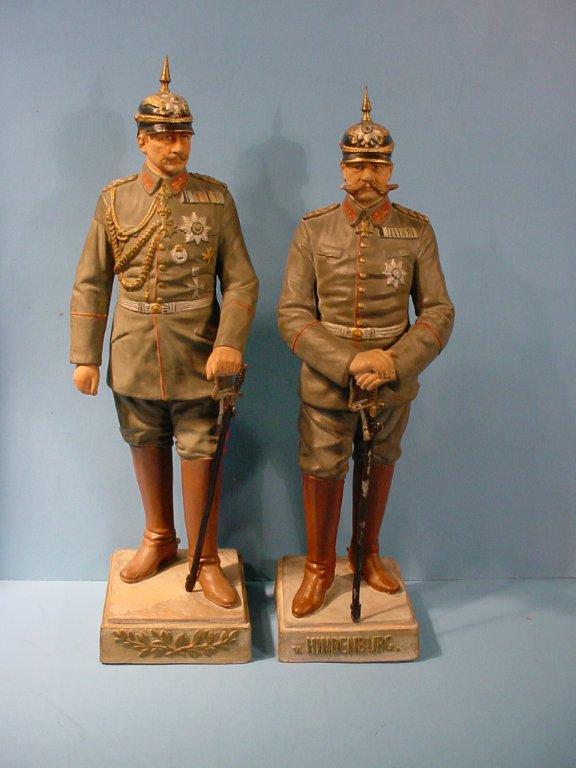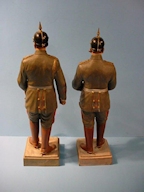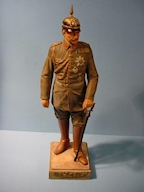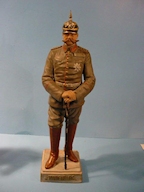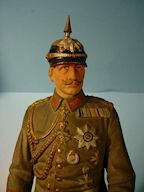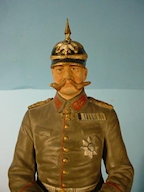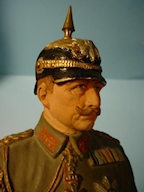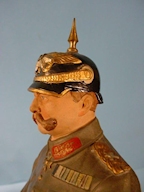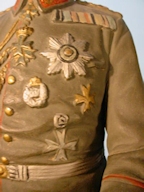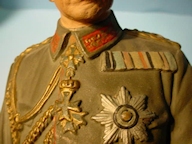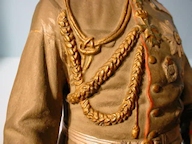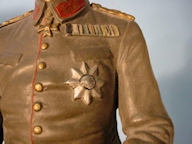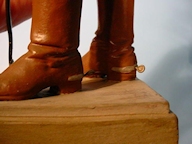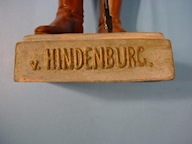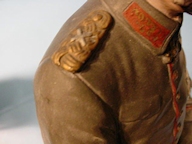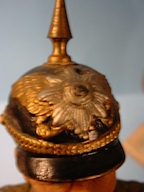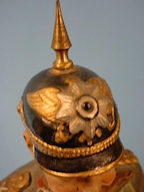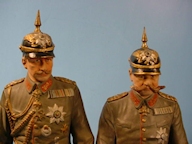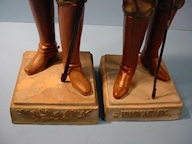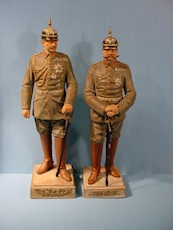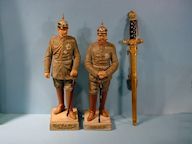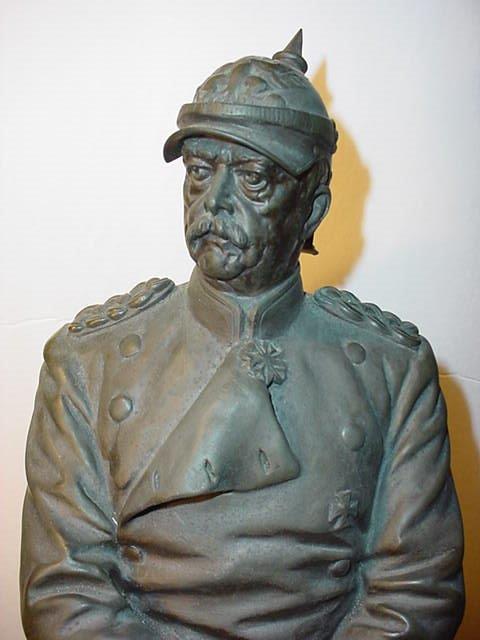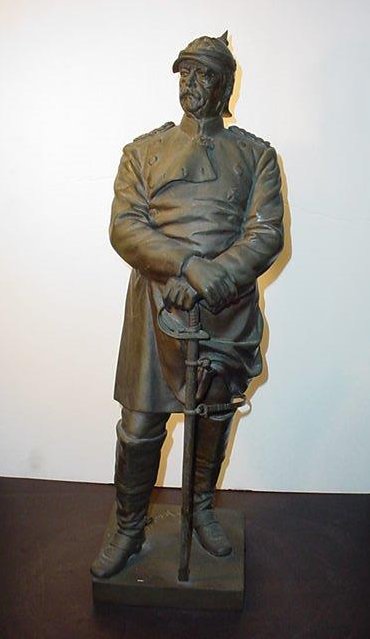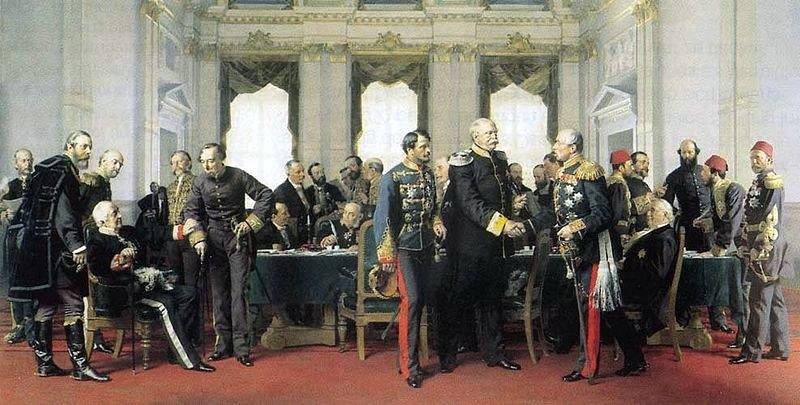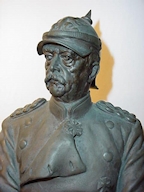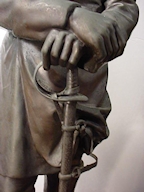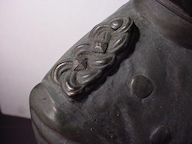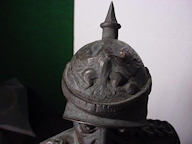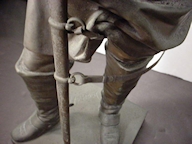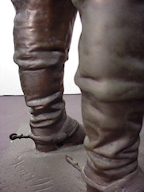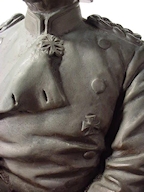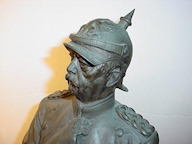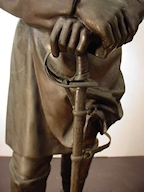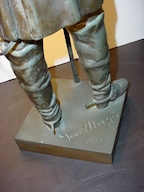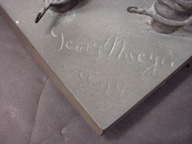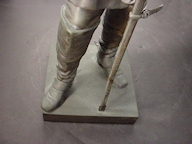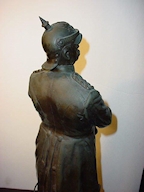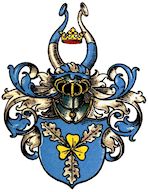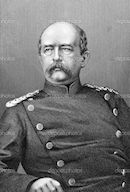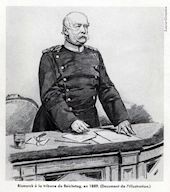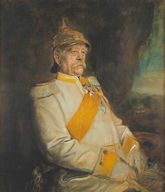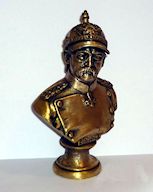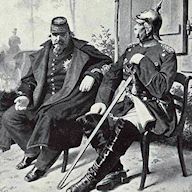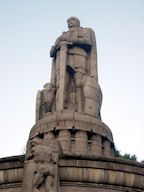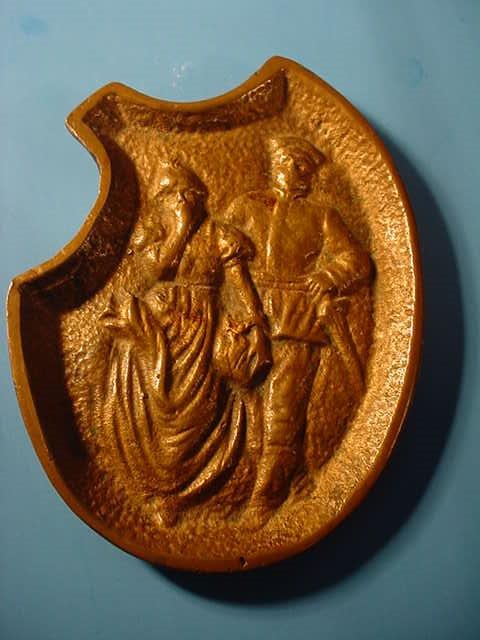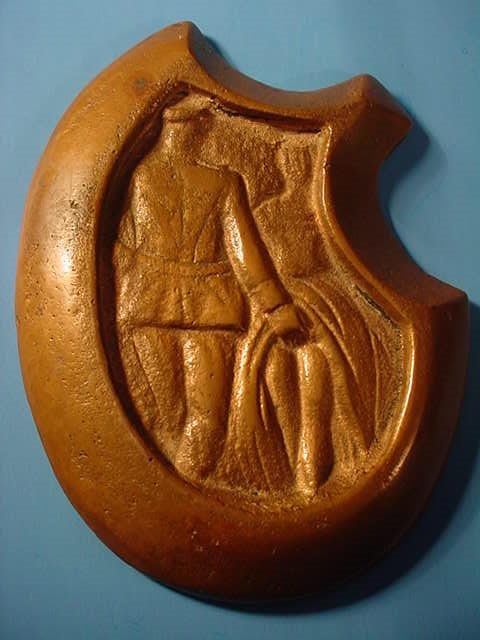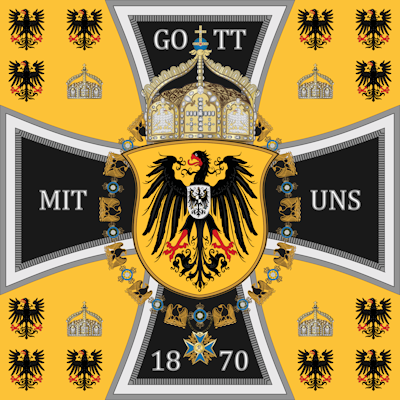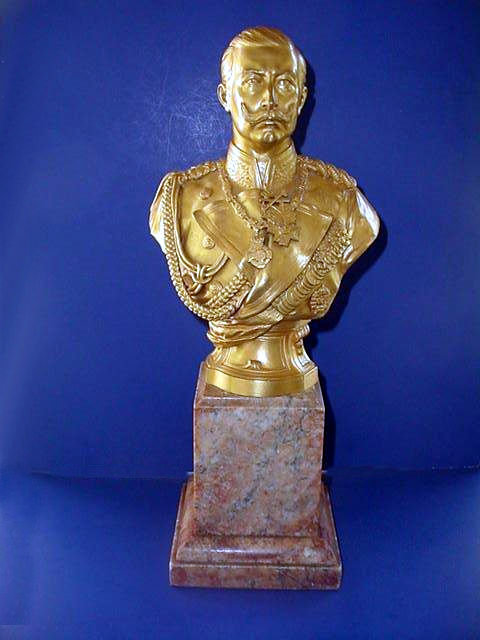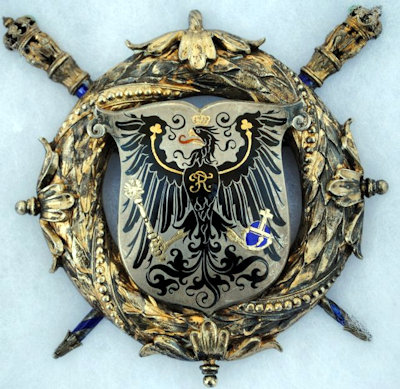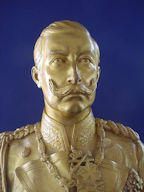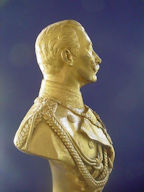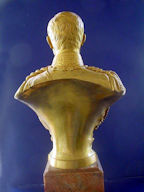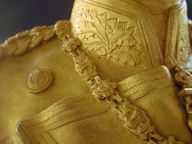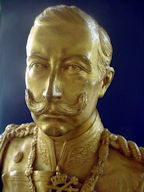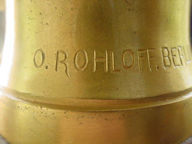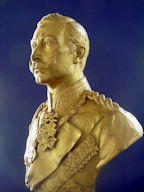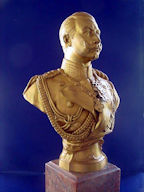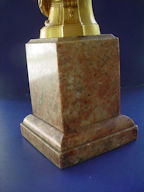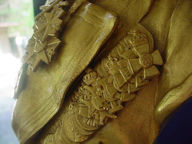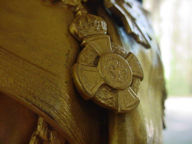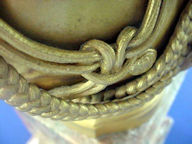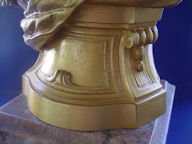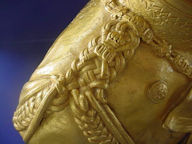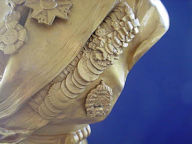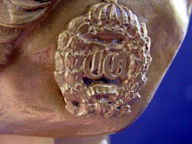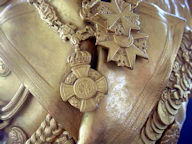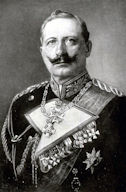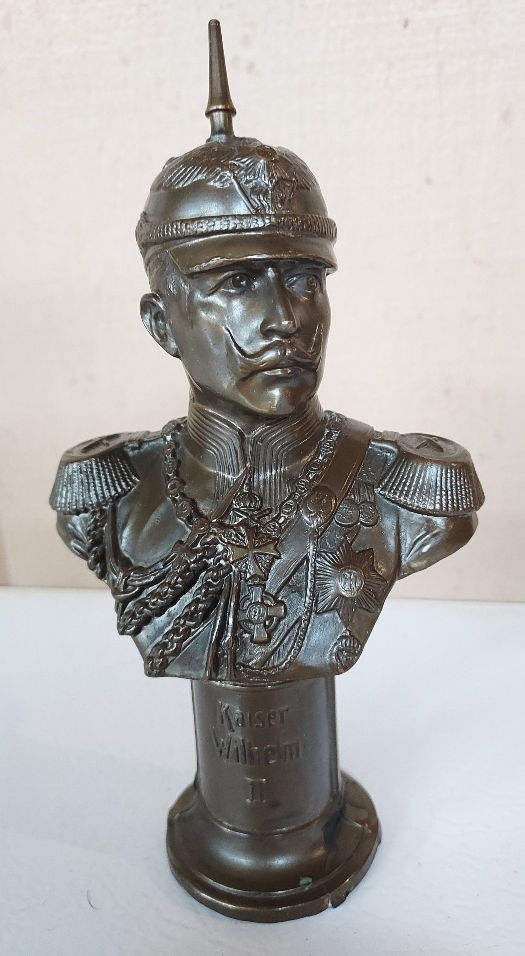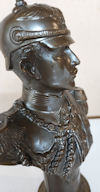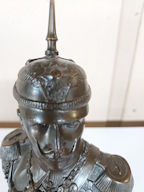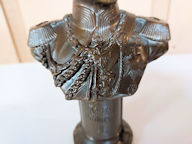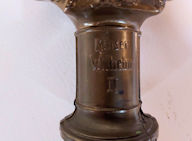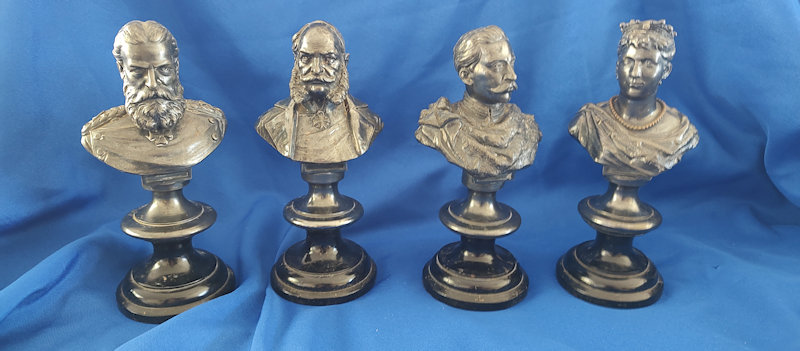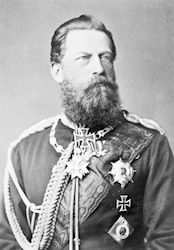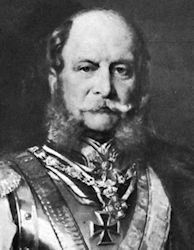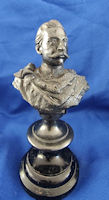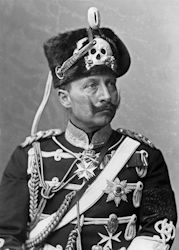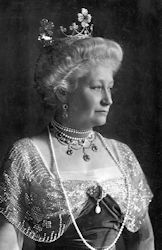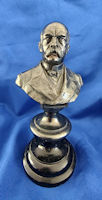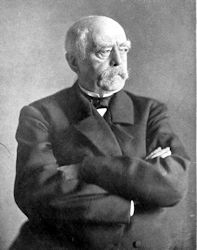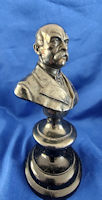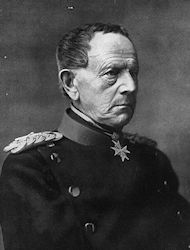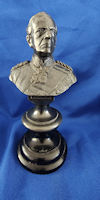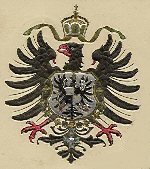|
|
|
|
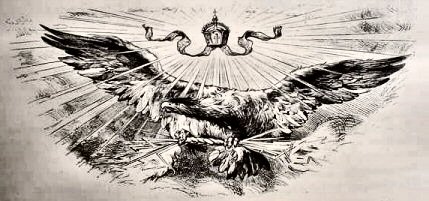

Bronzes and Statuary
Page 5
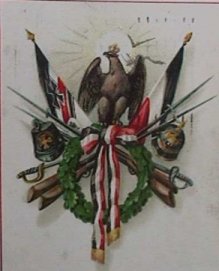
Please be sure to visit our Kaiser Wilhelm II collection.
Also, take a look at our Frederick the Great gallery.
|
|||||||||||||
|
Magnificent Bronze of Saint George and the Dragon (Item KSTATUES 5-1; FRAN 3-12) |
|||||||||||||
| DESCRIPTION:This is one of the finer bronze sculptures that we have ever beheld. It is surely Madison Ave gallery grade. It depicts the beloved warrior Saint George on his steed riding off after slaying the fierce dragon. This saint was depicted in the coats of arms and crests of both Imperial Russia and England. He represents all the good and noble against the forces of darkness. The knight depicted is a bit unusual in that he has already killed the evil serpent. Usually he is depicted as he actually enters into mortal combat with the creature. The detail is exquisite. The artists name signed to it is G. Ferrari. I was able to find an Italian artist in Gormans bronze book volumes by the name of Carlos Ferrari but it is possible that G Ferrari could be of the same family. This was often the case in France and Italy where the entire family would be involved in the same or similar artistic creations. The sculpture is 16 ½ inches high with a base that is 11x 5. the horse from tail to snout is 14 inches long. This is one of the best equestrian figures we have ever had the pleasure of offering at Germania.
PRICE: SOLD |
|
Statue of Otto Leopold V. Bismark (Item KSTATUES 5-2) |
||
| DESCRIPTION:This is a very nice statue in bronze of Chancellor Otto.v. Bismarck “The Iron Chancellor” of Germany. He was the greatest mover for German unity and he was the greatest statesman the Fatherland ever knew up to 1933 when Adolf Hitler rose to power. Bismark was a very forceful chancellor. His favorite saying was, WENN DIE DEUTSCHEN ZUSAMMENHALTEN SO SCHLAGEN SIE DEN TEUFEL AUS DER HÖLLE”. (It meant, “When the Germans act in cohesiveness even the devil shakes in hell.”) He was the father of German Einigkeit (Unity). His name will always be honored in German legend and praise. Many streets in the Fatherland are named for him. Even though some are being renamed with such as Martin Luther King Street, Ernest Thalmann Street, or Yitzak Shamir Street. Probably there will be a George Bush Street as well. Why not? BUT someday when pride and nobility return to Germany once more and the occupation ceases. Hail Bismark! The statue stands 11 inches high and the marbleized base is 5x5 inches. The statue has been professionally painted with life like colors but did not originally come that way (at least that is what we suppose). It is quite nicely done. A great decoration and collectable.
PRICE: SOLD |
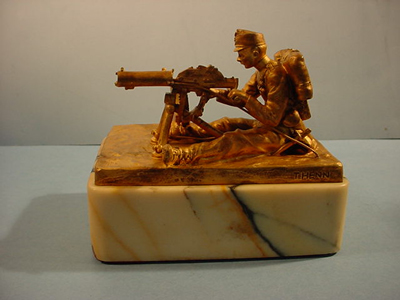 |
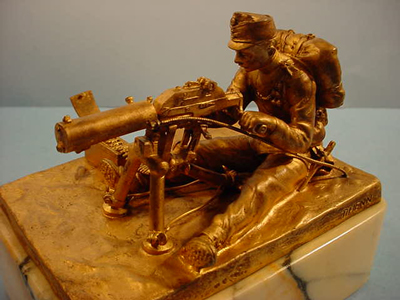 |
Magnificent Bronze of a WWI Austrian KuK Stormtrooper with Machine Gun (Item KSTATUES 5-3 & IMP 1-3, BRONZEMET 1-8) |
||||
| DESCRIPTION: The Austro-Hungarian forces in World War One were some of the best but led by the worst. This is a wonderful sculpture in genuine Austrian Bronze of a Austrian "Sturmtruppen” member manning a belt fed Schwarzlose water cooled M-712 machine gun. This gun was fed via a 250 round magazine fabric belt and could fire up to 500 rounds per minute. The soldier is shown with the full issue uniform with field pack, canteen,and bayonet in scabbard. He has the marksmanship award in the form of an agulette looking braided cord worn from the left shoulder board. The phenominal accuracy of the whole sculpted presentation is great. This is a true Austrian bronze in every sense of the word and miniature Austrian bronze are highly sought after by collectors worldwide. We have see the Bergmann “Kitty Kats” Dachshunds, Monkeys, Foxes etc., but to find a military subject is extremely rare indeed. The piece is signed T. Henn and has a copyright stamp that says ‘Henn Vienna’ in a circular stamping. This is in addition to the artist signature. The sculpture is mounted on a piece of thick genuine Austrian marble as a base that is 1 ½ inches thick and measures 5 ½ x 4. The metal base is 5 inches long and 3 ½ wide. From the bottom of the metal plinth or base the soldier is 3 ½ inches high. From the front muzzle of the machine gun to the back of the field pack the measurement is 4 ½ inches. The piece is quite heavy being genuine bronze and marble. The Sturmtrooper is wearing the Austrian issue cap that resembles the WW II .M-43 cap All in all this is a really wonderful museum specimen, extremely rare and historically significant and will make your desk look like it is in KuK Hauptquarters. This is in a word -- “Special.” PRICE: SOLD |
||||
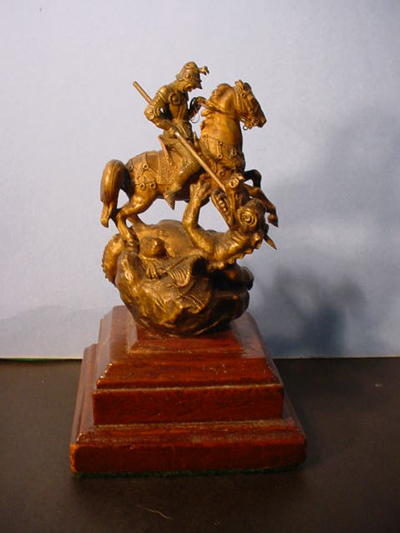 |
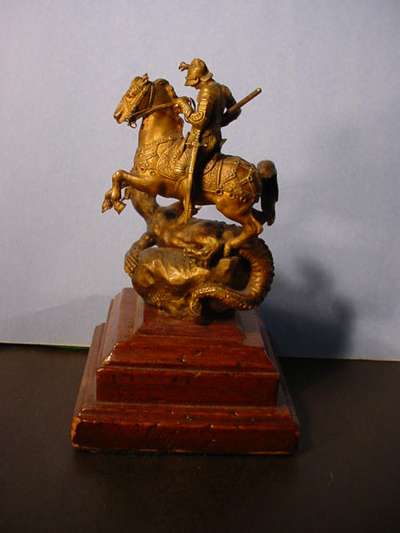 |
Bronze Statue of St. George Slaying the Dragon (Item KSTATUE 5-4 & ART 17-3, BRONZEMET 1-5) |
DESCRIPTION: This is a subject ever poplar and revered by Europeans, German, Russian, English, Scottish and a host of others. These people equated Saint George with bravery, loyalty and patriotism. He represented the noble knight errant, true to his cause and courageous enough to do battle with the dark side represented by the Dragon or Serpent. Certain races and creeds have alternatively embraced the dragon or reptile as their talisman and identified with it and so it was and is down through history. This is a small but magnificent bronze artistic study of the legend. Some of the worlds finest bronze statuary was done in the miniature. The sculpture is about 5 inches high and the wooden base is about 2 ½ inches high. The piece is signed and we make it out to be to I. Curts, an Austrian artist of fame who is noted for his small, decorative and utilitarian pieces. The dates we find for him are 1895-1929. But for some reason, numerous art connoisseurs believe that Curts was a pseudonym for Carl Kauba. The statue certainly shows the detail and masterful sculpture of Kauba’s work. References and other pictured works of this artist are shown on numerous pages of the encyclopedia of bronzes and sculptures 1800-1930 assembled by Harold Berman. The measurement from the horse's tail to his snout is about 3 inches. The sculpture is in very good condition and just about perfect. The detail is astoundingly good. The Knight wears the typical armor of the 11th century with a helmet from which a dragon perches. This is an exciting art piece and is very reasonably priced. This is a museum quality sculpture and should be cased in a glass display case with lights shining upon it all by itself – it is absolutely that good! PRICE: SOLD |
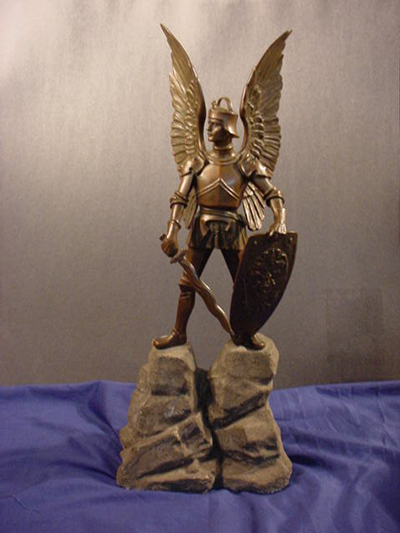 |
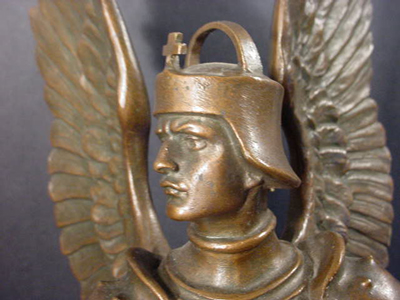 |
Austrian Bronze Statue of Saint Michael Guarding the Austrian Border (Item KSTATUE 5-5 & WWI 12-1 & IMP 1-2, BRONZEMET 1-6) |
DESCRIPTION: This is a magnificent bronze statue of the Patron Saint of Imperial Austria armed with sword and shield. He stands defiant and steadfast as he guards the area known as the “Isonzo” named for the Isonzo River that runs from the Gulf of Trieste through Italy and Slovenia and joins with the Sola and Idrija Rivers as it ambles toward Austria. The battles of the Isonzo were a series of 12 battles between the Austro-Hungarian and Italian armies in World War One. They were fought along this river on the Eastern sector of the Italian front between June 1915 and November 1917. Most of the battles were fought on the territory of modern Slovenia and the remainder in Italy. During the war the Isonzo valley was part of the Alpine sector of the Italian Front, along which the armies of Italy and Austro-Hungary clashed. During World War One the sixty miles long river ran almost entirely inside Austro–Hungary in parallel to the border with Italy. There is a narrow corridor between northern Italy and central Europe. This corridor is also known as the “Ljubijana Gate.” The Italian army wanted to break through this passage in order to penetrate into central Carniloa and then on to Stynia to the heart of Austria. The area between the northernmost part of the Adriatic Sea and the sources of the river Soca thus became the scene of twelve successive battles with the rest of the mountainous 400 mile long front almost everywhere dominated by Austro-Hungarian troops. The Isonzo was the practical area for Italian military operations during the war. The Austrians had fortified the mountains ahead of the Italian long expected entry into the war on May 23rd, 1915. The details of the battles are available on the internet; we won’t go into further description here. Fratricidal War at its Most Heinous. Despite the huge effort and resources poured into the continuing Isonzo struggle the results were invariably disappointing and without real tactical merit, particularly given the geographical difficulties that were inherent in the campaign. Cumulative casualties of the numerous battles of the Isonzo were enormous. Half of the entire Italian War casualty total some 300,000 - 600,000 were suffered along the Isonzo. Austro-Hungarian losses while by no means as numerous were never the less high at around 200,000 of an overall total of around 1.2 million casualties. The statue stands today as a memorial to the brave Austrian soldiers who died in those twelve battles as defenders of their sacred fatherland the figure of Saint Michael depicted with the wings of an archangel. His sword is the wavy blade type and his shield has the double headed eagle of the Hapsburg Empire. The bronze figure stands at the peak of a simulated mountain. This model mountain is formed from actual Austrian granite from the area of Austria where such stone is quarried. The realistic tone is exemplified by this clever artistic touch. The whole of the sculpture in height including the granite base is 15 inches with the base being 6 inches high and Saint Michael being 12 inches. The sculpture and base are in A-1 perfect condition. Very dramatic looking and noble in its concept. This is one of the most meaningful art statues we have ever presented to serious Germanophiles worldwide. By the way, we might need a St. Michael or St. George at our border in the near future to guard against the Dragons and Devils from south of that besieged border. Let’s support Arizona! In Hoc Signo Vinces!!! PRICE: SOLD |
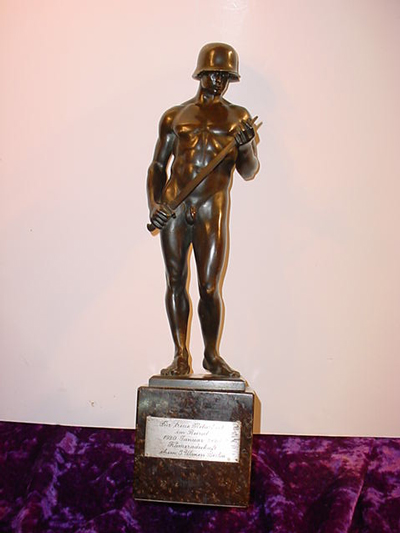 |
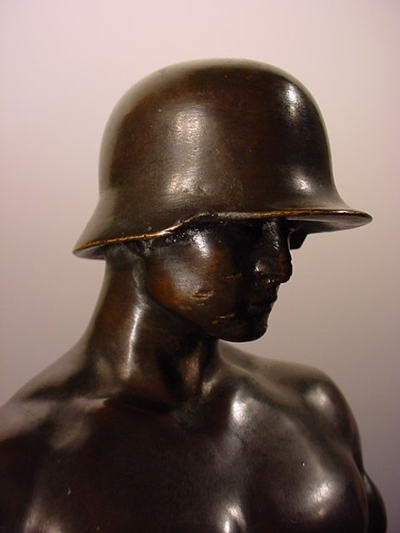 |
Bronze Soldier of the Reich (Item KSTATUE 5-6, WWI 12-2, ART 16-10, WEHR 31-14) |
DESCRIPTION: This marvelous statue measuring 13 ½ inches high with a base 4 ½ inches square (length and depth) personifies the strength and determination of the “Deutscher Soldat” from the time of the battle of the Teutoberg Forest up through the pages of history and into the 2nd World War. The slogan that might go with this wonderful sculpture could be “Die Ganze Welt Gegen Uns”! The whole world against us! Yes, Germany in the embodiment of the Heilege Vaterland was always to protect Europe against the constant incursions from the east against the Magyars, Huns ,Goths, and Visagoths and even the moribund Roman Empire. The land of Germania and its Teutonic Volk took on all comers. It was no different in the 2nd World War when Germany with a few allies stood against the Maelstrom in what was a German led crusade to destroy the beast of Bolshevism before all of Europe was disseminated by what President Regan later called the Evil Empire. Tthis was truly “evil personified! “ And in this author's perception, all the nations who joined in the fight to preserve communism and crush Germany were the acolytes of Stalin and Tito and obviously Satan*. (*Authors historic opinion.) The statue you see here tells of a saga that we have briefly touched upon in the forgoing narrative. As this Warrior stands naked before the world, the artist who sculpted him conveys in statuary the defeated yet proud and militant German soldier who wears the Stalhelm (steel helmet) and makes ready the sword of Siegfried known as Nothung for the next time the call of the besieged Fatherland is heard. We readily admit that all of this will only be understood and honored by Germanophiles, but we can envision all the deep meaning that this artistic masterpiece conveys. Nothing else that we have ever offered or seen offered comes up to the artistic expression and important significance of this prodigiously important piece. Its historical importance is magnificently conveyed. This statue which may actually be unique; it is a presentation piece to an officer who was “Beirat” (military advisor) to the Third Ulan battalion in Berlin. This wonderful gift was from the Kameradschaft (comrades) and presented to him for his true service to the Batt. From 1920 to 1940 this illustrious unit was the Third Guard Uhlan regiment and in WW 2 the Uhlans became armored divisions and covered themselves with glory in the early campaigns in Poland and the military engagements against France and Russia. The sculpture weighs about 14 pounds with the marble plinth and is in perfect condition with a gorgeous patina throughout. Deutschland Uber Alles ! PRICE: SOLD |
 |
 |
A Soldier Ashtray (Unique) (Item KSTATUE 5-7 & WWI 12-3, BRONZEMET 1-7) |
DESCRIPTION: This has to be one of the neatest WWI German novelties of the Imperial Era we have ever seen or heard of. This Pickelhaube wearing Prussian soldier is a ‘Bandsman’ and “what a bandsman.” He is playing the “Grosse Trommel” (Grand Drum) and the large cymbal at the same time. He is in full Prussian Landser uniform with the ‘Birds nest” or swallow tail epaulettes on his shoulders and the special three button style cuffs that are sported on the dress tunic. He wears the Mauser 98 bayonet with portepee. The absolute most unique thing about “Fritz’ is found in his moving parts -- when the arm holding the drum stick is depressed downward, he raises the cymbal and brings it clanging down when the drumstick is returned to its original position. Of course when the cymbal is raised the ashtray is exposed. Behind ‘Fritz’ is a small plinth where a pack of matches would be mounted. The figure is mounted on a base that is made to look like a brick street. Under the base are letters, D.R.G.M. (German registered patent) and another word is found by the base fixtures. It could be Mustersch.? The figure with base stands about 8 inches tall. The drum is about 2 ½ inches long. The cymbal is about 2 inches in diameter. We at Germania are particularly proud to offer this great figure to the collecting pubic and at the same time in hopes he doesn’t go out too soon, he looks great on our desk. In all probability ‘Fritz’ was a table piece in an officer’s Mess Hall. He is certainly not a toy. PRICE: SOLD |
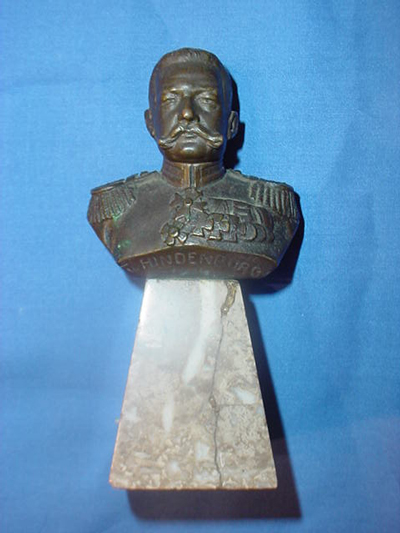 |
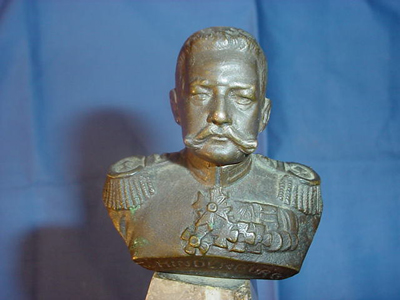 |
Small Bronze Bust of General Field Marshal Paul von Hindenburg (Item KSTATUE 5-8 & WWI 12-5 & PERS 4-16) |
DESCRIPTION: This is a great little sculpture mounted on a marble base. It is highly detailed and an excellent likeness of the Great War leader who later became the first post-war president of Germany. He later appointed Adolf Hitler Reich’s Chancellery. There is a narrative about this much loved and respected leader in several of our pages and the Kaiser Reich section on bronzes and statuary page 4 at KSTATUE 4-2 and also on the Third Reich page 14-1. He was known as the “Father of the Fatherland” and Germany’s greatest war hero. Please do read about him on our pages at the WWI section. This is a fine period bust and a great historically important item. Small but dramatic! The bust with its plinth stands 4 3/4th inches high and the bust alone is 2 1/2 inches high; it is signed Burajze. The medals and birds nest shoulder boards and stand out in amazing detail and the face is remarkably life-like. The artist certainly captured the spirit of the grand old Marshal. PRICE: SOLD |
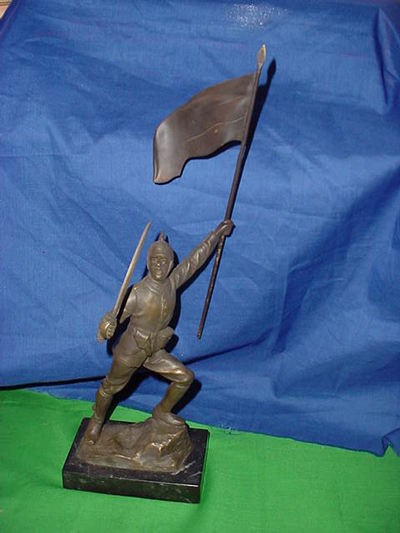 |
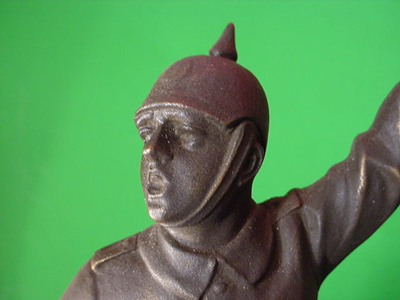 |
WWI Soldier in Bronze with Banner (Item KSTATUE 5-9 & WWI 12-7) |
DESCRIPTION: This is a bronze sculpture by famed Paul Schmidt Felling 1835 - 1930. He was one of the most famous artists doing human figures in his time. Farmers, children, workers, soldiers and some animal figures, he was a very prolific artist and was most known for his very dramatic figures but also his Volkskunst(Art of the People). This example is a patriotic theme with a soldier of the Fatherland in the pose of officer holding the schwarz, weiss, rot banner as he advances with drawn sword. The officer seems to be rallying the troops for a charge against the enemy. The banner is seen to be divided into sections that, were they in color, they would be the national colors of black, white and red. We have seen a larger version of this Felling statue in a German art museum and it had the name ‘Vorwarts’ or ‘Forward.’ Certainly an appropriate title for this extremely melodramatic figure that is so striking and full of meaning to the Germanophiles among us. PRICE: SOLD |
 |
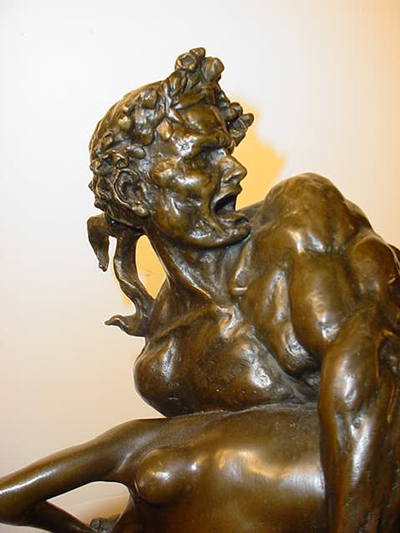 |
Statue of Centaurs from Greek Mythology from the Hermann Goring Collection (Item KSTATUE 5-10, GOR 11-2 & BRONZE 1-1) |
DESCRIPTION: This is a very rare and beautiful bronze statue by C.B. Albert a famed artist who was the creator of many fine statuary figures. The bronze depicts the famed Greek mythological figure Centaurs with a captured young virgin female. The bronze cast is of the finest quality imaginable in a metal sculpture. The Legend: Centaurs was the Father of the race of mythological beasts known as the Centaurs of Ixionidae. The Centaurs are half man, half horse. They were said in Greek mythology to be wild, savage and lustrous. They were widely known for their extreme drunkenness as it is said that the Centaurs could not hold their liquor at all, and were drunk all the time. So you see an example of this drunken lust in the depiction we offer of Centaurs with the “damsel in distress”. So realistically portrayed that after viewing it for a time you will start to believe in mythological beasts. This is a big and very heavy bronze. It stands 21 inches high including its beautiful three piece marble base that is a work of art in itself. Absolutely stunning! The center portion of the statue is about 18 inches from the front hoof to the end of the tail. The statue actually was from Castle Veldenstein, Goring’s estate where he had moved his innumerable treasures near the end of the war. But, we do not add a nickel to the price because of this. The statue stands on its own merit as a meaningful masterpiece of the sculptor’s art. We have managed to procure many things from the Goring’s estate, Veldenstein, and we have elsewhere on the site explained how this came about but again this is in fact a Göring possession but not sold based upon this fact. You must appreciate this statue for what it is artistically, and although we know it would have been the art most enjoyed and collected by ‘Unser Hermann’ (Our Hermann as he was called by the German populace). It has no presentation plaque or any other proof of his ownership. It is exactly what his artistic preference would be in fact we also like it very much. We have been known to be the web site that has featured some of the best and most important examples of this ancient art form. You can read much more about Centaurs by putting the name into Google and the Wikipedia explanation will come up and it is quite informative on the subject. You can also see the painting from which this bronze was depicted. PRICE: SOLD |
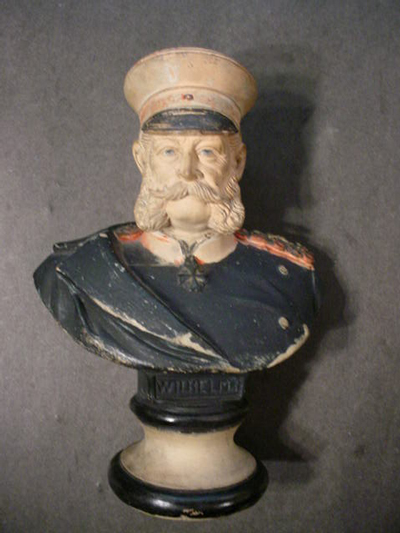 |
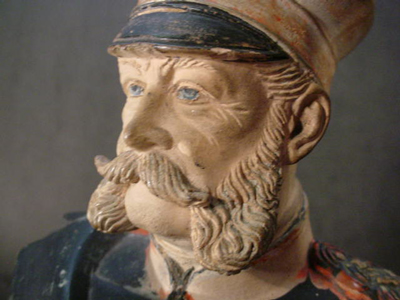 |
Miniature Bust of Kaiser Wilhelm the First (Item KSTATUE 5-11) |
DESCRIPTION: Born in 1797, he was probably the most beloved of the German emperors, and memorials to his memory are found all over Germany. Even in his lofty position, his kindness of heart even toward the humblest servant could not be excelled but he was a soldiers, soldier from top to bottom possessing all the virtues of that class. He had a high sense of duty, courage and exactness in the smallest details. Like his great ancestor Fredrick II (“The Great”) he regarded himself as the first servant of his country. Significant are his words when asked at the end of his life to stop work for a while on account of his weakness, he replied “I have no time to rest.” He was the indispensible cog in the wheel of Empire along with his faithful friend and councilor, Prince Otto Von Bismarck in building the new German empire after he and his generals crushed the French army in the Franco-Prussian war. Much more about this great monarch can be found on the internet. The bust is in a terra cotta material and it is unbelievably lifelike. It stands about 5 inches high and is in fine condition but with some of the paint on the tunic and plinth worn here and there. The face is so fine and realistic you would think he could breathe. There is a mark on the back of his tunic that spells depo. This could refer to the artist or the issuing company. A great little sculpture of a grand and great ruler. PRICE: $225.00 |
 |
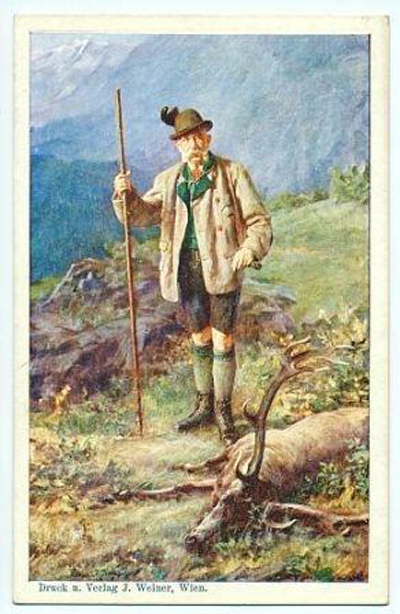 Emporer Franz Josef with trophy stag |
Plaque Depicting Emperor Franz Josef of Austria (Item KSTATUE 5-12, IMP 1-6, BRONZEMET 1-4, BRONZEMET 1-4) |
DESCRIPTION: This is a beautiful large bronze plaque that is mounted on its original wooden base piece. It depicts Kaiser Franz Josef, the Hapsburg monarch who was Emperor of Austria, King of Bohemia, King of Croatia, Apostolic King of Hungary, King of Galicia and Grand Duke of Cracow from 1845 until his death in 1916. He had many tragedies in his life including the suicide of his son the Crown Prince Rudolf in 1889 and the heinous murder of his wife the Empress Elizabeth in 1898. He became the war time partner of Kaiser Wilhelm II in the Great War that followed the assassination of Archduke Franz Ferdinand the heir to the Austrian-Hungarian throne. This activated a system of alliances which resulted in World War One. Franz Josef died on 21 November 1916 after ruling his domains for almost 68 years. He was a much beloved ruler who enjoyed the love and adoration of his people. One of the few pleasures and pastimes that this royal personage ever afforded himself was hunting and fishing. He was an avid hunter and indulged in this sport on every occasion that he possibly could. He had several hunting lodges in the Austrian Alps and the Wienerwald (Vienna forest). This plaque depicts him in his jagertracht (hunting garments) with the jaunty hat with partridge brush. This is a very exact likeness of the grand old emperor. A piece of magnificent bronze art. It is mounted nicely on a beautiful wood base measuring 21 ½ inches by 17. The actual bronze plaque measures 11x15 inches. Below the bust portrait of Kaiser Franz is the Hapsburg crown surrounded by laurel leaves on one side standing for empire and on the other side you can see pine branches and pine cones (hunting décor). There is a signature of the artist F. Krebs 1908 and there is also a mark of the bronze castor that looks like it indicates a patent protection with numbers (Shutz = protected!). This is an absolutely beautiful art piece and is truly rare and important to the history of our times PRICE: $1,850.00 |
|
|||||||||||
|
Bronze Statue of Saint Hubertus by Franz Sautner (Item KSTATUE 5-13, BRONZEMET 1-2) |
|||||||||||
| DESCRIPTION: This is a magnificent likeness of St. Hubert, or Hubertus, by famed German artist and sculptor, Franz Adolf Saunter, 1872-1945. Sautner is featured with several of his bronzes in the encyclopedic set entitled Bronzes: Sculptors and Founders 1800-1930 by Harold Berman. Saunter was a prolific artist in his time producing many charming and historically important sculptures. The legend of Saint Hubertus is beloved by the German people in the Fatherland and throughout the world. The legend recounts that in the early 1600’s, the wealthy Hubertus was supposed to join his family and other villagers, who were crowding the churches on Good Friday. But being a compulsive huntsman and, reputedly, a poacher, he withdrew into the forested Ardennes and gave himself to his hunting compulsion. He sallied forth to the chase and as he was pursuing a magnificent stag, the animal turned and as the pious legend narrates, Hubertus was astounded at perceiving a crucifix standing between the stag’s antlers. Then he heard a voice saying: “Hubertus, unless thou turnest to the Lord and leadest a holy life thou shalt quickly go down to hell.” Hubert prostrated himself immediately and cried out “Lord, what wouldst Thou have me to do?” He then received a set of commands and instructions and he was a godly man ever after and became the patron saint of hunters, forest workers, and trappers. When one sees the stag with the cross used by many hunt clubs and organizations you know that Saint Hubert is about. How he actually became a saint is a whole separate story. The saint and the stag-and-cross symbol are seen throughout Germany, as the legend is sacred to Germanic mythos and faith. Paintings, bronzes, and architecture abound throughout Germany. We show some of these artistic masterpieces that incorporate the story of this noble saint. This bronze statue by F.A. Saunter is a wonderful depiction of this legendary figure of history and religion. It measures 15 inches high and has the stag’s head with the cross in the base; with this is the artist’s signature. The bronze base sits on a marble plinth. Hubertus holds the crossbow and wears his hunting horn. The costuming is typical of the garments of huntsman of the period.
A great sculpture and a great legend – Horrido!
PRICE: $2,850.00 |
|
|||||||||
|
Kaiser Wilhelm Equestrian Statue (Item KSTATUE 5-14, BRONZEMET 2-9) |
|||||||||
| DESCRIPTION: This is a magnificent depiction of Germany’s most beloved king and kaiser, Wilhelm the First, His Hohenzollern Majesty. It is in fine art bronze with a wonderful patina and is as fine a likeness of the warrior king as we have ever seen. It was this fearless monarch along with Prince Otto Von Bismarck that smashed the French Empire’s army to pieces in the Franco-Prussian War and established the unity of all the various states into a unified Germany and he goes down in history as the first German Emperor reigning from 18 January 1871 to 9 March 1888. It was at the Hall of Mirrors in Versailles that he was proclaimed German Emperor. He was the father of Kaiser Frederick Wilhelm III and grandfather of Kaiser Wilhelm II of WWI fame. He was termed “The Warrior King” and he served in the Prussian Army from 1814, onward. He fought against Napoleon I of France and was reportedly a very brave soldier. He fought under Gebhard Lebercht Von Blucher at the Battles of Ligny and Waterloo. During the Revolution of 1848. Wilhelm successfully crushed a revolt that was aimed at his elder brother, King Frederick Wilhelm IV.
In his memoirs the great Chancellor Otto V. Bismarck describes Wilhelm as an old-fashioned, courteous, infallibly polite gentleman and a genuine Prussian officer whose good common sense was occasionally undermined by ‘female influences’. Wilhelm was extremely monarchist and blatantly antisocialist (*to his everlasting credit). Obama wouldn’t have liked him at all! Several assassination attempts were made against him by leftist street scum during his reign. An antisocialist law went into effect signed by the emperor in 1878 almost entirely prompted by Prince Bismarck who said: “If I don’t want any chickens then I must smash the eggs!” Still he was most beloved by the masses of his people. His grandson, Wilhelm II, idolized his grandfather and he was instrumental in later attempts to foster a cult of the first German emperor as “Wilhelm the Great.” Wilhelm’s primary interests were the army and hunting, and most pictures of him show him in the uniform of the Garde du Corps, along with his personal elite corps of stalwart soldiers who wore the Prussian eagle perched upon their helmets. The magnificent equestrian statue that we offer is probably the finest likeness of the Kaiser that we have ever seen. During his reign and long after, there were more than 1,000 memorials to him including the famed Kyffhäuser monument in Thuringia and the equestrian one at Deutsches Eck where the Rhine and the Mosselle meet near Koblenz. The Americans in their lusty destructive zeal to destroy all German historical sites and monuments purposely fired artillery shells at it in 1945 thereby utterly destroying the magnificent gigantic statue. (KULTURTRÄGERS!) With German reunification in 1990, the Düsseldorf sculptor, Raymond Kittl, was commissioned to produce a replica of the original statue and now one can see a perfect re-creation of the sculpture in place. The original statue had an inscription on its base that said “Nimmer wird das Reich zerstöret, wenn ihr einig seid und treu! (Never will the Empire be destroyed, so long as you are united and loyal!). This bronze that we offer, as you can see from our images, is wonderfully detailed. The measurements are 15 inches from the muzzle of the horse to its tail and 16 inches from the bottom of the base to the top of the emperor’s Garde du Corps helmet. See a beautiful example of this type of helmet with an explanation by going to KHELMET 2-11. The bronze signed by the artist W. Uhlmann and the foundry are seen on the base and here is none other than the famed H. Gladenbeck and Sohn. Acktion Gesellshaft in Berlin. So, collectors, here is just about the finest bronze that you will ever see that so graphically depicts this illustrious emperor and heroic figure of the west.
PRICE: $6,950.00 |
|
|||||||||
|
Tray Commemorating Kaiser Wilhelm I in Berlin (Item KSTATUE 5-14a, BRONZEMET 2-9a) |
|||||||||
DESCRIPTION: In the articles at KSTATUE 5-14 (above) and BRONZEMET 2-9, we show a magnificent equestrian statue of Kaiser Wilhelm Hohenzollern I. We mentioned in the accompanying article that there were more than 1,000 statues and memorials to him for he was indeed Germany’s most beloved king and Kaiser. He was also the ‘Warrior’ King. In his defeat of Napoleon III, he secured and declared the unity of the German states; announced and joyfully proclaimed at Versailles. This tray shows the Triumphal Plaza in Berlin along with a magnificent equestrian statue of the Kaiser with the Gates of Triumph in the background. This was probably the greatest of all the memorials to him. To read more about Germany’s imperial hero of the ages, go to the aforementioned narratives where we explain his life and times in more detail. The tray is an important relic from the time of imperial pomp, circumstance, and glory. PRICE: $145.00 |
|
||||||
|
“Der Sieg!” (The Victory!) (Item KSTATUE 5-15, BRONZEMET 2-11) |
||||||
| DESCRIPTION: This is a beautiful depiction in bronze sculpture of a warrior of the old Germanic Reich around the year 9 CE, when an alliance of Germanic tribes led by Hermann or Arminius of the Cherusci tribe ambushed and decisively destroyed three Roman Legions along with their auxiliaries led by Publius Quinctilius Varus. The battle known as the “Hermannsschlacht” totally stopped the Romans’ concerted efforts to conquer and permanently hold” Germania” beyond the Rhine River. Around 15,000-20,000 Roman soldiers died and Varus and many of his officers are said to have taken their own lives by falling on their swords in the approved manner taught to them as soldiers of Rome. Tacitus wrote that many officers were sacrificed by the Germanic forces as a part of their indigenous religious ceremonies; many were cooked in pots and their bones used in rituals. However, others, including enlisted personnel, were ransomed and enslaved. The warrior in bronze we offer has a helmet that may be constructed on the anvils of the very technically advanced Cherusci or it’s one taken from a Roman auxiliary soldier. The sword is typically Germanic, but the shield is 100-percent Roman of the type used exclusively by officers; the face on the shield might betray artistic license to some extent and could depict Arminius or even Varus. The height of the sculpture is exactly 2 feet from the bottom of the marble plinth to the point of the sword. The measurement of the warrior from foot to the top of his helmet is 13 ½ inches not counting the upraised arm. The Germanic warriors usually fought like the Picts of ancient Scotland—in the nude—thereby not being encumbered by bothersome clothing that curtails direct action of the arms and legs. They were fierce fighting men, who expected no quarter and gave none in battle. This is a very fine bronze and it’s signed. Although the artist was a master at depicting the human figure his signature is almost illegible. If anyone recognizes the artists name from the picture of the signature that we show we would be most appreciative. There is a foundry mark from Ernst Kraag in Berlin stamped on the base. So, here we have an important art bronze that tells part of the story of the most important historical battle of all time. Heil Hermann, Heil Germania. Sieg Heil! PRICE: $2,850.00 |
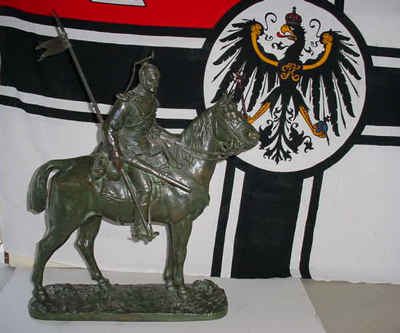 |
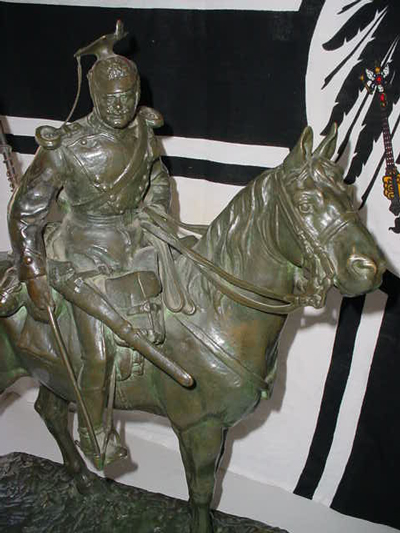 |
Massive Equestrian Bronze Statue of the 5th Regiment Prussian Uhlans (Item KSTATUE 5-16; WWI 12-15; BRONZEMET 3-3) |
DESCRIPTION: This is a magnificent bronze depiction of a mounted horseman of the Fifth Uhlan Regiment of the Kaisers 3rd Cavalry Division attached to the First German Army Command. They served with particular distinction in the Franco Prussian war and WW1. Uhlans were light cavalry, actually Lancers, who fought with carbines, swords, and lances. The title Uhlan was used by Lancer regiments in the Russian, Austrian and especially the Prussian armies. Uhlans typically wore a double buttoned tunic (Kurta) with a colored panel at the front, a colored sash and a square topped Lancer cap (Czapka), also spelled chapka. This cap was originally derived from a traditional design of the Polish civilian cap made more formal and stylized for military use. Their Lances usually had small swallow tail pennants known as the Lance Pennon that was found just below the spearhead (see our pictures). Prussian Uhlans distinguished themselves and fought bravely in the war against Napoleon. In WW1 the Imperial German Army included 26 Uhlan regiments. They all saw action while on duty at the first part of the war and their charge with lances struck fear in the hearts of the enemy since it has well been known that these were formidable warriors adept at warfare (up front and personal!). Later in the second year of the war the Uhlan regiments were either dismounted to serve as cavalry rifle regiments in the trenches of the western front or transferred to the eastern front where primitive conditions made it still possible for horse cavalry to play an effective role. In WWII a popular myth is that Polish cavalry armed with lances charged and were annihilated by German tanks during the 1939 campaign; this arose from the misreporting (both intentional and unintentional) of the charge at Krojanty on 1 September when two squadrons of Polish 18th Lancers armed with lances and sabers were met in combat by German cavalry led by Harry Von Johnston in what was the last charge of German cavalry with sabre. The Poles were dispersed and defeated by Germans who rode one last time in the spirit of the Old Prussian Uhlans. This is a little known fact of history that for the most part has remained hidden for all these years. The bronze statue is accurate in every detail and prodigiously dramatic in its heroic depiction. It is a huge and heavy sculpture done in the finest mode of German bronze art. It measures 26 inches high from the bottom of the base to the top of the Uhlan Czapka. The horse is 22 inches long from tail to muzzle. The base is measured at 19 ½ x 7 inches. The sculpture is signed by Leon Mignon (1847-1898), a sculptor from Brussels, Belgium. He studied under the sculptor Prosper Drion (1822–1906) at the Académie in Liège from 1857 to 1871. He was a particular admirer of the anecdotal sculpture of Léopold Harzé (1831–1893). His vocation as a sculptor of animal subjects began in Rome, where he studied on a grant from 1872 to 1876. He exhibited in Ghent (1874) and on several occasions in Paris (where he lived from 1876 to 1882) at the Salon des Artistes Français. He achieved prominence at the exposition Universelle of 1878 in Paris with his bulls fighting in the Roman countryside (Brussels, mus. a. mod.). In 1880–81, he shared a studio with the Belgian sculptor Paul DeVigne, whom he had met in Rome. Mignon’s bull tamer (liège, parc avroy) took the gold medal at the Salon of 1880. In 1882 he settled in Brussels and in 1888 produced the labors of Hercules reliefs for the stairway of the palace of Charles de Lorraine (now part of the Bibliothèque Royale Albertier). He sculpted several historical figures for the provincial law courts and was an astute philosopher of his time. In 1892 he sculpted many subjects for the Université de Liège. He excelled as a sculptor of animal subjects. Mignon occupies a leading place in Belgian realist art. He also modeled busts of Belgian personalities as well as a statuette of the Belgian painter Hubert Bellis; figurines of workers, soldiers from the Belgian regiments (c. 1889), and even an equestrian statue of a Prussian Uhlan, France’s enemy in the 1870 war; and a statue of Leopold in 1886 ( Brussels, mus. a. mod.). His works are preserved in the Musée de l’art Wallon, Liège, and the Musée d’Art Moderne, Brussels. He was completing a frieze for the Hôtel Somzée in Brussels when he died unexpectedly. He was an amazing artist and a cultured man of vision. A grand museum grade art piece personified and extraordinaire! It is priced under market value for a sculpture as fine as this one is. It is certain that one could not find any such dramatic artistic accomplishment to rival this one. Here he is! In all his Imperial glory. Listen as you view him and perhaps, just perhaps, you will hear the strains of “Heil Dir im Seigerkranz” (Hail to thee in Victors Crown.) Deutschlands Helden Lebt in ewig leben! PRICE: SOLD |
|
|
Set of Fantastic Statues of Kaiser Wilhelm 2 and Field Marshal Hindenburg (Item KSTATUE 5-17; KTOY 1-11; WWI 12-16) |
|
DESCRIPTION: Beautiful almost beyond belief! Here is a grouping of the most famous luminaries of the WW-I period. They are constructed in terracotta material and hand painted to true perfection and historic accuracy as to uniforms, medals, etc. These are period pieces from Imperial Germany and NOT Chinese-made toys that flood the market today. These two heroic figures are genuinely 100 years old, at least! They are so realistic looking that they practically breathe. The life-like quality of these figures could never be captured in bronze or metal of any kind. The faces are like fine portraits. The detail is so great that even the spurs on their boots are still there. (See our picture). It is nothing short of incredible that they survived this long in the pristine condition that they are in. (They are perfect!) Just imagine these pieces standing erect in the midst of your helmet collection. We can really say that these two figures are the finest depictions in artistic creativity we have ever seen (worldwide). Probably no bronze, in fact, no painting can be more realistic than these two items for beauty and historical significance. They could NEVER be duplicated today.
PRICE: SOLD |
|
||
|
Risqué Bronze Ashtray (Item KSTATUE 5-20; WWI 13-16) |
||
| DESCRIPTION: Here is a humorous little ashtray as sold in German army PXs during the WWI era. It depicts a German Lanser accompanied by a blushing young maiden. The reason for her blushing is seen when you turn the ashtray over and see where the soldier’s hand is being placed. These were commonly sent home to a man’s friends or brothers as a little humor from the Front that soon after would be no joking matter. Size is about 4½ x 3½ inches and is cast in genuine bronze. Some have been seen over the years cast in spelt. This one is unusual presented in bronze.
PRICE: $100.00 |
|
|||||||||||||||||||||
|
Spectacular Golden Bronze Bust of Kaiser Wilhelm II by a Berlin Artist (Item KSTATUE 5-21; WILHELM 9-25; BRONZE 2-11) |
|||||||||||||||||||||
| DESCRIPTION: Without a doubt, here is the finest artistic depiction of German royalty ever created by a sculptor. The bust is rather large measuring 17½ inches high including the base. The actual bust size is about 11 inches high, while the base is triple mounted on the finest of rose-colored marble; the larger portion being about five inches high and four inches square. The beautiful marble base is in great condition throughout. The most incredible part of this depiction is the fact that the medals and orders are obviously cast separately and adhered to the Kaiser’s chest. The monarch is wearing the House Order of Hohenzollern, the Order of the Red Eagle, and the Order of the Black Eagle. Down the front of his tunic you can see about twenty separate medals put together in a medalist mounting. The aiguillette is also separately molded and applied to the work. The uniform that the Kaiser is wearing is the high dress, admiralty tunic. The buttons show fouled anchors upon them. The Berlin artist O. Rohloff, who must have had the royal approval to create such a magnificent piece of the sculptor’s art, created this bust. Busts and statues with this high-gloss finish were generally featured in governmental buildings as an entrance piece in a foyer. There are other busts of the Kaiser out there, but this one is rare in the extreme! This one is with 22k extremely fine gold plate and is rarely, if ever, found or seen. You could never find a more beautiful depiction of the German emperor.
PRICE: SOLD |
|
||||||
|
Bronze Sculpture of Kaiser Wilhelm II (Item KSTATUE 5-22; WILHELM 9-30) |
||||||
| DESCRIPTION: Here is a small, fine version of a bust of Kaiser Wilhelm II in cast bronze to include the attached plinth. It has extraordinary detail with all the correct medals including the Pour le Meríte and the Hohenzollern medals. The shoulder boards indicate that he is wearing the Prussian guard uniform. The plinth that he is featured with is inscribed “Kaiser Wilhelm II.” This is a casting probably from Aktion Gessellschaft in Berlin. He is seven inches from the bottom of the base to the tip of the spike of the helmet. Items like this were generally special door gifts presented to members of the Imperial staff upon their royal visitations and on occasions such as the Kaiser‘s birthday. We have had many Kaiser busts, but this little gem gets a hardy approval for detail and excellent correct facial features and uniform display.
PRICE: $950.00 |
|
|||||||||||||
|
Set of Busts of the German Royal Family (Item KSTATUE 5-23; BRONZEMET 4-13) |
|||||||||||||
| DESCRIPTION: This is a wonderful grouping of four busts: Kaiser Wilhelm I; Kaiser Frederick III, son of Wilhelm the I; and the latter’s son, Kaiser Wilhelm II. Beside the latter is Kaiserin Augusta Victoria, Kaiser Wilhelm’s I loyal wife. Below, from the same artist, we are selling the Iron Chancellor, Otto von Bismarck; and General Helmuth von Moltke, Chief of the General Staff from 1859-1888. The meticulous detail is beautiful on these from the military honors on the uniforms to the jewelry of Kaiserin Augusta; and the faces are true to life. There is no maker’s mark. They weigh about 1 pound 3 ounces each so we believe they are nickel and not of base metal. They are about 7 inches high by a little over 3 inches wide which includes the wooden base. These are truly marvelous collectibles from a time of honor and grace, war and peace.
PRICE: $499.00 for the set |
|
|
||||||
|
Busts of Otto von Bismarck and General Helmuth von Moltke, Chief of General Staff (Item KSTATUE 5-24; BRONZEMET 4-14) |
||||||
| DESCRIPTION: In the same artistic degree as the set of the Hohenzollern family above, and from the same artist.
PRICE: $125.00 for each |
Page Five |
|
|
|
Please refer to item designator in parentheses in all correspondence.
Please E-mail for any additional information you may need.If you prefer, contact 'Germania' at PO Box 68, Lakemont, GA 30552
or call at 706.782.1668.
Please! do not call during the wee hours of the morning. The best time for calling us is between 9 and 11 am and between 9 and 11 pm eastern time.


